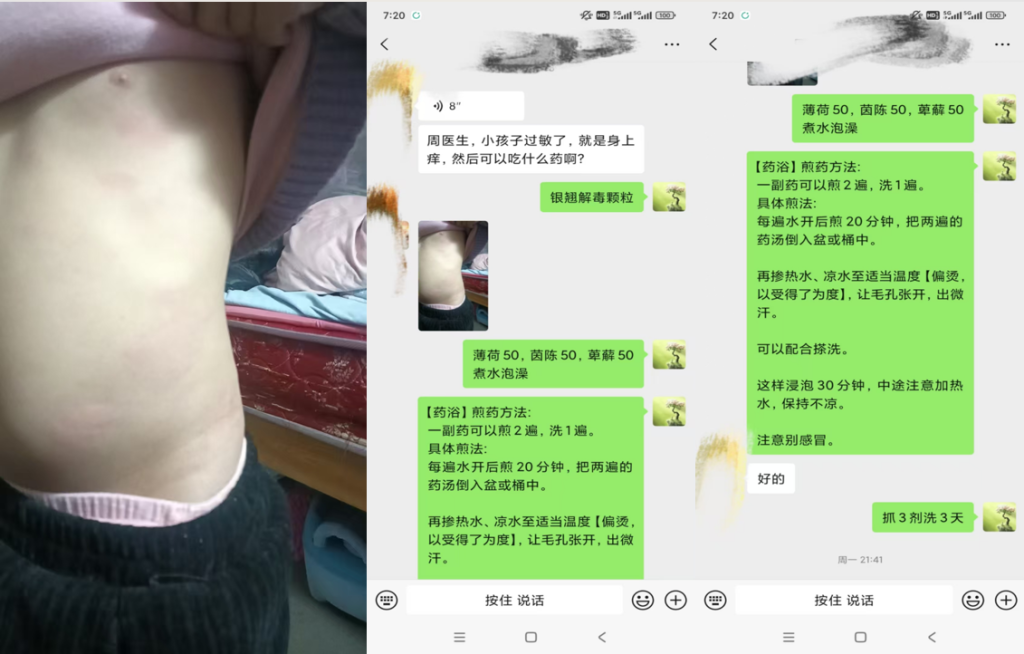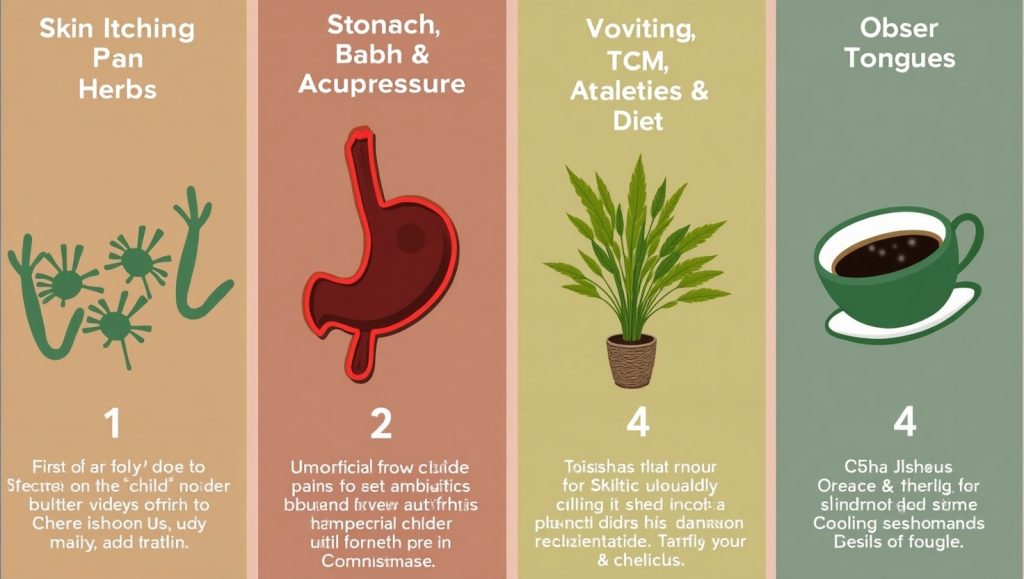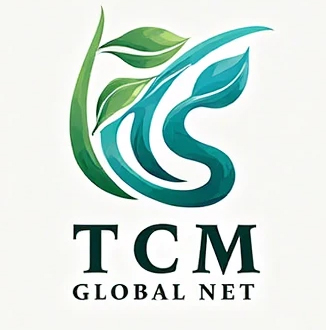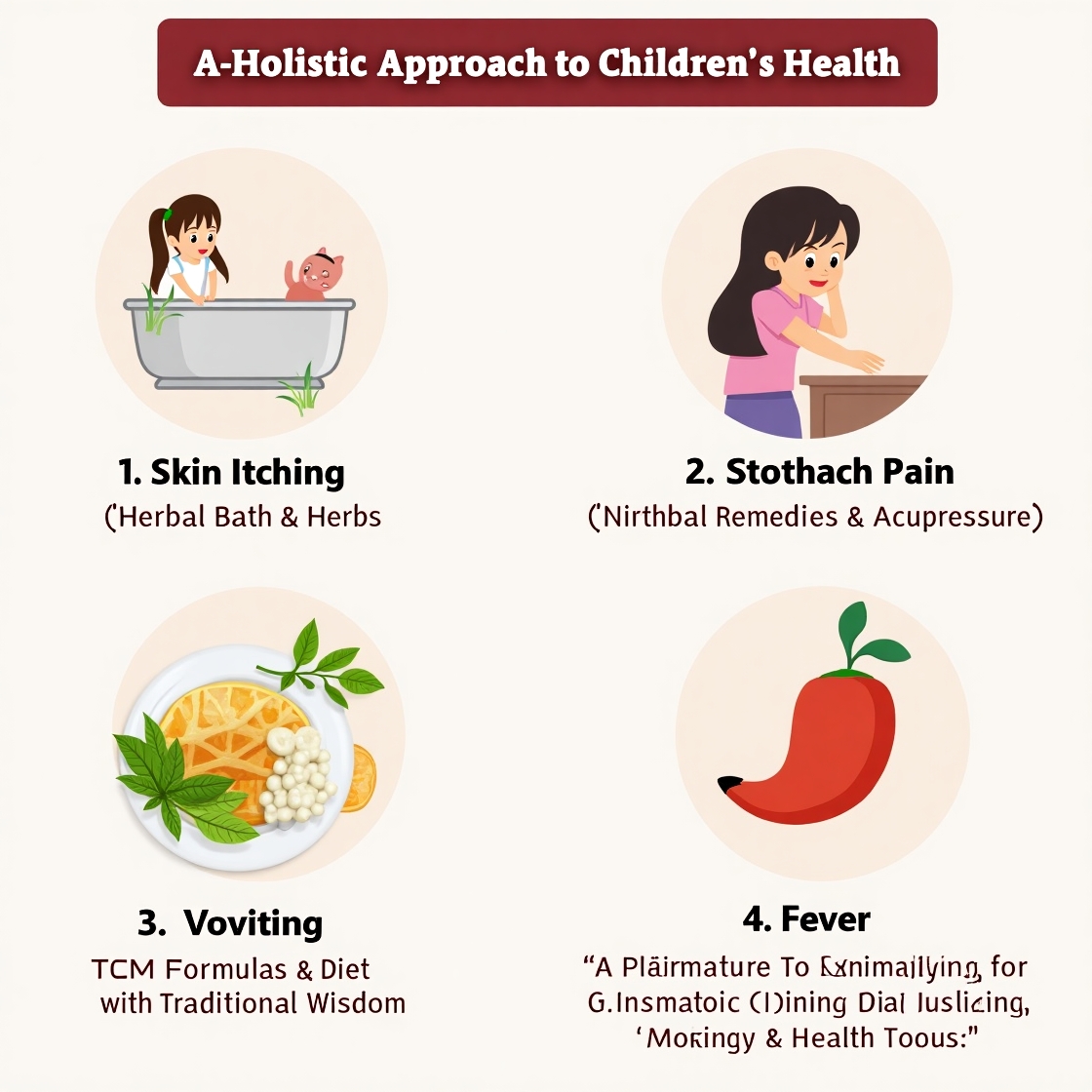I. Introduction: The Importance of Addressing Children’s Health Issues, with TCM Differential Diagnosis and Treatment as Key
Children’s health issues often cause anxiety for parents, especially when faced with sudden symptoms such as skin itching, abdominal pain, and fever, leaving them at a loss. This article will combine two real cases to analyze the causes of common pediatric problems from a Traditional Chinese Medicine (TCM) perspective and provide simple and effective solutions to help parents better manage children’s health issues.
II. Case One: Allergic Urticaria in Children – The Dual Impact of External and Internal Factors
1. Case Description: A mother noticed her child’s skin developing itching and red patches, diagnosed as urticaria.

2. TCM Cause Analysis: The causes of urticaria in children can be analyzed from both external and internal factors: ① External factors: Recent frequent weather changes may have caused the child to catch a cold, leading to wind-cold pathogens invading the skin and causing itching. ② Internal factors: ☆ The child may have a significant amount of damp-heat in the body, which accumulates in the skin, causing red spots and itching. ☆ Many children have varying degrees of damp-heat, which is related to irregular diet and spleen-stomach dysfunction.
3. Treatment Suggestions:
① Oral Medication: Yin Qiao Jie Du Granules: They have the effects of dispelling wind and relieving exterior syndromes, clearing heat and detoxifying, and are effective for urticaria. Suitable for children with colds, fever, and sore throat, they can help alleviate discomfort and restore the child’s spirit. Recommended reason: Yin Qiao Jie Du Granules are mild and suitable for children, effective for various symptoms, and can be kept at home.
② External Treatment: Herbal Bath Formula: Ingredients: 50 grams of mint, 50 grams of capillary wormwood, and 50 grams of phellodendron. Usage: Boil the above herbs in water, and once the water temperature is suitable, let the child bathe in it. Mint can dispel wind and scatter heat, capillary wormwood can clear heat and promote diuresis, and phellodendron can dispel wind and remove dampness. Combined, they can effectively relieve skin itching.
4. Treatment Results: After one day of treatment, the red spots on the child’s body subsided, and the itching significantly reduced.
5. Precautions: Parents can adjust the herbal bath formula according to the child’s specific condition, but it is recommended to use it under a doctor’s guidance. If the child’s symptoms persist or worsen, seek medical attention promptly.
III. Case Two: Abdominal Pain and Vomiting in Children – The Combined Effect of Internal Heat, Food Stagnation, and External Pathogens
1. Case Description: A mother’s child experienced abdominal pain and vomiting, with the vomit being watery.

2. TCM Cause Analysis:
- Tongue Image Analysis:
- The blue area on the tongue surface has a noticeable shadow, indicating the presence of cold in the body.
- The tongue surface has red strawberry spots, indicating an internal heat constitution.
- Cause Analysis:
- The child has a significant amount of internal heat, combined with food stagnation, leading to spleen-stomach dysfunction.
- External wind-cold pathogens invade, combining with internal pathogens, causing an acute gastrointestinal reaction, manifesting as abdominal pain and vomiting.
3. Treatment Suggestions:
- Recommended Chinese Patent Medicine:
- Ge Gen Qin Lian Granules: The original formula consists of kudzu root, scutellaria, coptis, and licorice.
- Effects: ☆ Kudzu root relieves muscle and reduces fever, raises yang and stops diarrhea. ☆ Scutellaria and coptis clear heat and dry dampness, purge fire and detoxify. ☆ Licorice harmonizes the other herbs, relieves spasms and stops pain.
- Mechanism of Action: This formula can separate and treat the dampness, heat, and cold in the intestines and stomach, expel toxins from the body, and prevent recurrent diarrhea.
- Advantages: Compared to the Western medicine montmorillonite powder, Ge Gen Qin Lian Granules not only stop diarrhea but also regulate gastrointestinal function, preventing chronic diarrhea.
4. Disease Progression and Management:
- Disease Recurrence:
- The child vomited again, and the mother was concerned about norovirus.
- TCM Perspective: The virus is not the root cause of the disease; the imbalance in the body’s environment is key. Improving the internal environment makes it impossible for the virus to survive.

- Medication Selection:
- The mother gave the child Ge Gen Qin Lian tablets, but they were ineffective.
- Reason Analysis: The potency of Chinese patent medicines varies with different formulations. Ge Gen Qin Lian Granules have stronger potency and are more suitable for acute symptoms.
- Symptom Changes:
- The child developed cold hands and feet, a sign of fever.
- Management Method: Change the medication promptly to reduce the fever first.
- After the mother gave the child Chai Gui Reti Granules, the abdominal pain was relieved, but the child experienced dizziness.
- TCM Explanation: This is a reaction to the treatment, indicating that the body is expelling toxins, showing that the medication is working.
- Pharmacist’s Suggestion:
- The pharmacist suggested changing the medication, but TCM emphasizes differential diagnosis and treatment, choosing medication based on the underlying pathology rather than just the symptoms.
5. Additional Reminders:
- Medication Administration:
- Chinese patent medicines can be taken in small sips to prevent the child from refusing due to the taste.
- Dietary Recommendations:
- After the child’s fever subsides or during acute diarrhea, it is not recommended to drink millet porridge; rice porridge is suggested because rice does not increase internal heat.
- Nursing Points:
- During the child’s illness, parents should closely monitor changes in the condition and communicate with the doctor promptly.
- Do not stop medication just because symptoms have slightly improved; continue taking the medication as prescribed.
- Do not be overly concerned about the side effects of Chinese medicine; Chinese medicine is mild and, when used correctly, is beneficial and harmless to the child’s body.

IV. Conclusion
- Whether it’s skin issues or gastrointestinal problems, a holistic approach is needed to analyze the causes and pathology.
- Parents should learn to observe the child’s tongue image and symptom changes and communicate with the doctor promptly.
- The same symptom may be caused by different factors, and treatment plans should be tailored to the individual.
- Parents should avoid blindly using medication and choose appropriate drugs under a doctor’s guidance.
- Maintain good lifestyle habits, eat a balanced diet, and avoid catching a cold.
- Strengthening the child’s constitution and boosting immunity is key to preventing diseases.


Leave a Reply